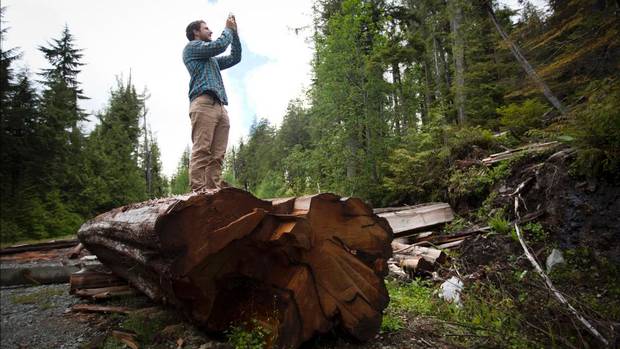A centuries-old cedar killed for an illicit bounty amid ‘a dying business’
Globe & Mail

The tree didn’t have a name, like the Three Sisters – three Sitka spruce nearby – or belong to a famous old-growth stand, like Vancouver Island’s Avatar or Cathedral groves.
But while it stood, the Western red cedar was a marvel, surviving rain and wind to last for 800 years and flourishing as forests gave way to subdivisions and highways.
And once protected within the Carmanah Walbran Provincial Park – the upshot of anti-logging protests – the cedar could have been expected to endure a few more centuries.
Now, however, it’s mostly gone – the victim of unknown poachers who put profit over sentiment.
As illicit bounties go, a giant cedar is among the toughest to hide, which explains why some of it remains close to where it fell, its trunk skewed across a parking lot and piles of sawdust marking spots where sections have been cut and hauled away.
It’s thought the tree was likely chopped into shake blocks: cross-sections that can be turned into cedar shingles. At nearly three metres across and 45 or 50 metres tall, the tree would have made plenty.
“Shake blocks would have been the quick and dirty way to do it,” said Colin Hepburn, a former logger who runs a Christmas tree farm near Duncan, B.C.
The tree’s fate resulted in a flurry of headlines this spring and a bounty for those responsible. It also highlighted the shady side of the forestry business, where commercial harvests are supposed to be monitored but where some theft occurs. The incident also spoke to changes on the Island, where shake-cutting crews and mills once peppered the woods but have become less common as suitable wood has become harder to find.
At Confederate Shake and Shingle, near Duncan, long-time manager Richard Gaudreault sees less old-growth timber these days. Holding up a shingle to illustrate, he points to the grain, ridges a millimetre or so apart. In the old-growth wood, by contrast, the grain is so tight you can hardly see it.
There used to be 20 or so employees at this mill. Now there’s a crew of six or seven. It is, Mr. Gaudreault says, “a dying business.”
There’s a $5,000 reward on offer for information that would result in conviction of those who cut down the tree. The groups behind the reward – B.C’s Wilderness Committee and the British Columbia Government and Service Employees’ Union, which represents provincial park rangers – say the tree’s fate is symptomatic of a system that has too few rangers looking after too much territory.
It’s not clear when the tree went down.
Mr. Hepburn was hiking in the Carmanah Walbran park in March, 2011, when he noticed it. It was standing, but nearly sawed through and with wedges jammed in cuts to ready it for felling. The wedges were small, like those used by shake-block cutters.Worried that the cedar could fall and kill someone, Mr. Hepburn e-mailed BC Parks.
He thinks it hadn’t been cut that long before, because he could smell fresh sawdust.
When he went back later that spring, Mr. Hepburn found the tree was down, with sections of it having been dragged into the parking lot.
BC Parks, mindful of the danger posed by a listing, approximately 10-storey tree, had hired a contractor to fell it on June 13, 2011, intending for the cedar to rot on the forest floor. Others, however, had more lucrative ideas in mind.
On May 17 – after learning parts of the tree were being hauled away – the Vancouver-based Wilderness Committee put out a press release, announcing the tree had been poached.
The Lake Cowichan RCMP detachment, under the impression the tree was newly cut, opened a file. So did RCMP’s B.C. forest-crimes unit, which turns out to be a one-person operation. The unit used to have four or five officers but has shrunk over the past decade as local detachments became more experienced in dealing with forest offences, the force says.
Forest crimes range from the petty – stealing firewood – to more ambitious operations. In 2009, following a lengthy investigation by the RCMP and provincial forestry officials, three men were charged with fraud in relation to a scheme that involved manipulating logs in order to pay lower stumpage fees to the province. Found guilty in March, the three are scheduled to be sentenced in July.
There is likely to be no such investigation of the toppled cedar in Carmanah Walbran park.
There’s no “CSI Carmanah” to chase down shingles made of old-growth wood, said Torrance Coste, the Wilderness Committee campaigner who announced the bounty. The RCMP did some surveillance after learning the tree was down, but it amounted to “closing the barn door after the horse was out,” said Sergeant Dave Voller of the Lake Cowichan RCMP.
There’s no mystery about the motive. Cedar is lightweight, straight-grained and rot-resistant. A cord of Douglas fir firewood – four feet high by four feet wide by eight feet long – amounts to a truckload and is worth about $180, compared with a truckload of shake blocks that could go for $1,000. For an unscrupulous person with the right equipment, the choice is easy.
“Any commodity that has value tends to be targeted by people who steal – copper wire is a case in point,” Sgt. Voller said.
The RCMP has closed its file on the case. BC Parks says it is still investigating. The province’s Park Act provides for a fine of up to $1-million, up to a year in jail or both for contravening the act, which prohibits taking trees from parks. Since B.C.’s Environment Ministry launched an enforcement database in 2007, there have been 39 cases of trees being removed from parks. Most of those were minor offences and resulted in tickets. An undisclosed number of “significant cases” remain unresolved or under investigation.
Estimates of what the cedar poachers might have made from their bounty – at least the parts they were able to haul away – range from a few hundred bucks to more than $5,000. In late June, BC Parks contractors were chopping up the rest of the tree.
It’s also not clear why the tree was cut and then left to lean last year.
Whoever is responsible might have been spooked by a coming vehicle. There’s only one road into the park and sounds carry a long way in the woods.
They might have made a strategic decision, reasoning that they’d made deep enough cuts that they could go away and wait for the wind to finish the job.
They might have been scared. Tree felling is dangerous work, fraught with the possibility of being crushed or impaled. Maybe, in the end, the poachers lost their nerve, rattled by a tree that looked like such an easy target creaking in what some might like to think was protest or even grief.
It can be an eerie feeling, Mr. Hepburn said. “It’s a little intimidating to stand beside them when they’re ready to go.”


